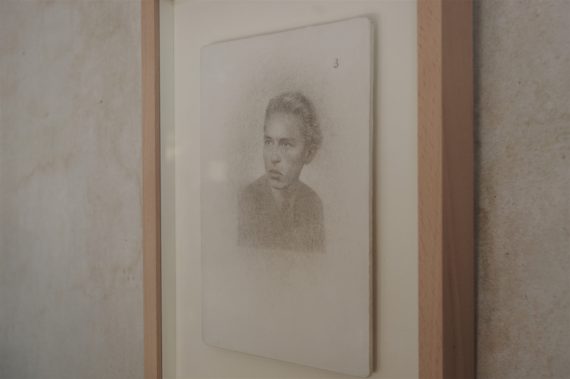There’s less than a week to go until the opening of the Trinity Buoy Wharf Drawing Prize 2018. The Trinity Buoy Wharf Drawing Prize is the new incarnation of what used to be the Jerwood Drawing Prize. Every year I make a point of going to see this exhibtion. I think of it as a kind of survey of contemporary drawing practice.
My work has been selected for it and I am very happy about that. The piece is called ‘Displaced Portrait No:3 (woman in carefully repaired image)’ and it’s one of an ongoing series of small silverpoint drawings based on posed photographs of people taken in Germany in the 1930s and 1940s. The photographs were found at different times in the same Margate junk. Somehow these discarded traces of moments in people’s lives have found their way into my hands and I have made drawings of them.
Drawing is a medium which expresses the passing of time. Hand-made drawings show the physical evidence of human touch and of movement, they are the physical traces of the presence of a mind at play, thinking and paying attention to the presence of something.
Drawings take time to come into being. Even the slightest trace has its life story of having began somewhere, change and finally coming to an end. Whenever we look at hand-made drawings we can experience a sense of Time’s presence. I’d like to think that my drawings put us in company with disparate moments in time and with the presence of others. Perhaps that sounds fanciful but it’s how I like to think about my Drawings.
My series of ‘Displaced Portraits’ are based on photographs of unknown people (unknown to me) taken in Germany in the 1930s and 1940s. Posed photographs can capture a moment of someone’s presence. For that moment they remained still and waited for the shutter’s click. We can become very aware of our own presence in time as we wait for that moment. If, like me, you hate having your picture taken these moments can feel excruciatingly long-lasting. But these moments are just moments. My drawings take time.
These drawings aren’t straight forward copies of photographs. Details are altered during my drawing process; a process of repeated scratching-away and re-drawing. It becomes a kind of meditation on the presence of people and of drawing and of the passing of time.
What can we tell about a person from their displaced image and how are we connected with each other? ‘Displaced Portrait No: 3 (woman in carefully repaired image)’ is based on a torn photograph. The photo was ripped in two and then subsequently glued back together again. It was so carefully mended that the damage is hardly visible at first glance. What was the story there I wonder? This series of drawings is ongoing.
The Trinity Buoy Wharf Drawing Prize opens from Saturday 29th September at Trinity Buoy Wharf, 64 Orchid Place, London, E14 0JY and runs until 17th October and then tours to various galleries across the country.
If you’re interested in knowing more about my work you can go to my wordpress blog, ‘Roy Eastland Drawing’ (https://royeastland.wordpress.com/), or you can find me on Instagram, twitter and on my artist’s facebook page: ‘Roy Eastland’.









